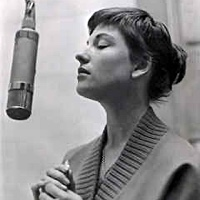Home » Jazz Musicians » Beverly Kenney
Beverly Kenney
Beverly Kenney was an American jazz singer.
Kenney's career began as a birthday singer for Western Union. After moving to New York City, she recorded a demo tape in 1954 with Tony Tamburello (the demo was released in its entirety in 2006 under the title Snuggled on Your Shoulder). By the end of the year, she moved to Miami and worked regularly at the Black Magic Room. For several months she toured with Jimmy and Tommy Dorsey's Dorsey Brothers Orchestra before returning to New York. Kenney said "Tommy and Jimmy liked me, but they thought I was too much of a stylist for the band. After a few months on the road, I left, and returned to New York", where she sang in clubs with George Shearing, Don Elliott, and Kai Winding.
Her big break came in October 1955, when she was featured in a Jazz Benefit concert for Israel at Carnegie Hall, sharing the bill with Miles Davis, Art Blakey, Tito Puente, and Marian McPartland. An October 25, 1956 newspaper ad lists Kenney as appearing at the Playgoer Room at the Westnor restaurant in Westport, Connecticut. At 24 years old, Kenney was beginning to become a fixture of the New York Jazz scene. She earned a standing gig at Birdland with Lester Young, and upon her debut at New York’s Basin Street Club, DownBeat critic Nat Hentoff praised her as compared to other artists. He said Kenney is “more flexible than Helen Merrill, swings more easily than Teddi King, and her musicianship and care for lyrics are far superior to Chris Connor’s.”
From 1956–1960, Kenney recorded six albums, three for Royal Roost and three for Decca.[1] Her first album, Beverly Kenney Sings for Johnny Smith (1956), recorded when she was 24 years old, with a quartet led by jazz guitarist Johnny Smith. She then began a residency at the Birdland jazz club accompanied by the Lester Young Quintet. Her television exposure consisted of one visit to The Steve Allen Show on May 18, 1958, performing the song she wrote "I Hate Rock 'n' Roll" and one appearance on Playboy's Penthouse, where Kenney coaxed host Hugh Hefner to sing "Makin' Whoopee" with her.
Steve Allen also wrote liner notes for her album Beverly Kenney Sings for Playboys (Decca, 1958) in which he commented, "A word to playboys: I would not recommend this album as Music to Make the Romantic Approach By. You're apt to get more interested in Beverly than the girl you're trying to impress."
Read moreTags
Beverly Kenney: Vocalist in Distress

Source:
JazzWax by Marc Myers
Beverly Kenney recorded seven albums between 1955 to 1959. She had a singing voice that was a cross between Blossom Dearie and Marilyn Monroe, but her approach on songs was courageous, taking risks on melodies that made her interesting to hear. What wasn't evident from her publicity photos—showing a poised, attractive and seemingly upbeat woman—was her depression. Kenney suffered terribly at a time when medications for mental illness were barely effective or were powerfully strong. Those who suffered often were ...
read more
Beverly Kenney After Dark

Source:
JazzWax by Marc Myers
As you'll soon see, only Playboy's Hugh Hefner could pour out champagne and then rest his forearm across the top of the bottle. On Hef's Playboy's Penthouse TV show in late 1959 or early 1960, one of his guests was singer Beverly Kenney. Amazing Kenney could remember the lyrics with her host staring at her so intently. But to Kenney's credit, she did manage to coax Hefner into singing with her on Makin' Whoopee. And it turns out he had ...
read more
- Barry Ulanov, Downbeat Magazine
“(Kenney is) more flexible than Helen Merrill, swings more easily than Teddi King, and her musicianship and care for lyrics are far superior to Chris Connor’s.”
- Jazz Critic Nat Hentoff
”Looks to me that 1957 will really be her year. I dig her because, well, she phrases like mad. She sings in tune, too; matter of fact, she sings like a musician."











